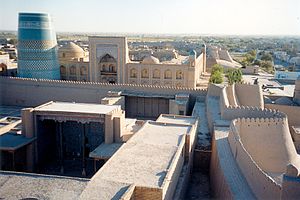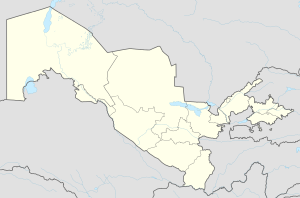Khiva
|
Khiva Xiva / Хива |
|
|---|---|

Walls of Itchan Kala
|
|
| Location in Uzbekistan | |
| Coordinates: 41°23′N 60°22′E / 41.383°N 60.367°E | |
| Country |
|
| Region | Xorazm Region |
| Population (2004) | |
| • Total | 51 200 |
Khiva (Uzbek: Xiva/Хива, خىۋا; Persian: خیوه, Xīveh; alternative or historical names include Khorasam, Khoresm, Khwarezm, Khwarizm, Khwarazm, Chorezm, and Persian: خوارزم) is a city of approximately 50,000 people located in Xorazm Region, Uzbekistan. According to archaeological data, the city was established in the beginning of the Christian era. It is the former capital of Khwarezmia and the Khanate of Khiva. Itchan Kala in Khiva was the first site in Uzbekistan to be inscribed in the World Heritage List (1991).
The origin of the name Khiva is unknown, but many contradictory stories have been told to explain it.
A traditional story attributes the name to one of the sons of Noah: "It is said that Shem [from whence the word Semitic is derived], after the flood, he found himself wandering in the desert alone. Having fallen asleep, he dreamt of 300 burning torches. On waking up, he was pleased with this omen, he founded the city with outlines in the form of a ship mapped out according to the placement of the torches, about which he had dreamt. Then Sim dug the 'Kheyvak' well, the water from which had a surprising taste. It is possible to see this well in Ichan-Kala (an internal town of Khiva City) even today."
Another story relates that travellers passing through the city, upon drinking the excellent water, would exclaim "Khey vakh!" ("What a pleasure!") and hence the city became known as Kheyvakh, whence Khiva.
A third proposal is that the name comes from the word Khwarezm, altered by borrowing into Turkic as Khivarezem, then shortened to Khiva.
In the early part of its history, the inhabitants of the area were from Iranian stock and spoke an Eastern Iranian language called Khwarezmian. Subsequently the Iranian ruling class was replaced by Turks in the 10th century A.D, and the region gradually turned into an area with a majority of Turkic speakers.
...
Wikipedia

